|
|
Beadsman

|
|
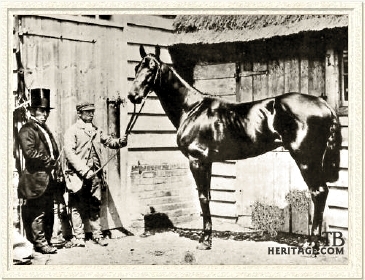 |
|
|
Beadsman was the last great sire in the Joe Andrews branch of the Eclipse sire line. He got some very good sons on the turf, and for a while their successes made him one of the most popular of stallions, none of them were able to get sons of sufficient quality to make a lasting mark in the stud. However, a number of Beadsman's daughters, and the daughters of some sons, were good broodmares and it is through them that we see his name in pedigrees today.

He was bred, and owned his entire life, by Sir Joseph Hawley (1814-1875), a baronet with a long, erratic, and sometimes contentious association with the turf. Unlike many aristocratic owners and breeders of the period, Hawley was intimately involved with the management of his stud and racing stable and he, rather than his trainers, made decisions on where and when his horses would run. Unlike many of his contemporaries, he was lavish in his reward of his winning jockeys and trainers, and despite -- or perhaps because of -- his close management of his racing string and stables -- he was admired and appreciated by his employees. His generous rewards to his staff did nothing to endear him to more traditional Jockey Club members, including the powerful Jockey Club steward Admiral J.H. Rous. Hawley also, for much of his early decades as an owner, moreso than many owners of the period, backed his horses heavily in their races, on several occasions winning thousands of pounds in wagers.
Later in life, in the late 1860s and early '70s -- ironic in view of his own history in running juveniles and placing big wagers -- Hawley was heavily invested in attempting to change contemporary racing practices, which put him at odds with much of the racing establishment. He took the position that racing two year olds was ruining both the horses, and racing in general. His campaign was to change Jockey Club rules to limit the trials of young horses, to prevent juveniles from entering handicaps, to prevent the Jockey Club from adding any monies to any two year old race, to disallow runoffs in dead-heats for two year olds, and to push the first races for two year olds further back in the season (first to July, and then, when he resubmitted his proposals, to September). He was also public in his criticism that the Jockey Club was failing in its function to promote the betterment of thoroughbred horses because it encouraged the production of precocious youngsters without stamina through its sanctioned races, and so becoming both a negative influence on breeding, and also a defacto means of supporting heavy gambling. While the public -- and some Jockey Club members -- supported Hawley's position, and briefly the Jockey Club established some rules, later rescinded, regarding running juveniles, the committee appointed to consider his charges regarding gambling determined such control was beyond its purvue. Hawley also argued for extending Jockey Club membership beyond its aristocratic and clubby exclusivity. He was bitterly opposed in all his proposals by Rous, who served for years as defacto president of the Jockey Club. At the end of two years of rancorous debate, within the Jockey Club and in the press, Hawley's proposals were largely unimplemented, and Hawley himself stopped attending races and in 1873, dispersed his stud.
Hawley, heir to Leybourne Grange in Kent, had, as a young man, raced horses in a desultory manner in Italy, where he struck up an association with J. Massey Stanley, and the two had imported some horses from England to run in the then largely haphazard races of Florence. When he returned to England at age twenty-six, he set up a small racing stable with a public trainer at Newmarket, and then he established his own stable at Fyfield in Wiltshire. The first of his eight classic winners, the filly Miami, won the Oaks for him in 1847. He hired Alec Taylor (senior) in 1848 as trainer at Fyfield. Taylor's first classic winners were Hawley's first Derby winner, Teddington, and Aphrodite, who won the 1,000 Guineas (and later ran second in the St. Leger) for Hawley that same year (1851). Taylor went on to train winners of a total of twelve classic races. It was Teddington's win, on which Hawley won £80,000 in wagers, and for which Hawley generously rewarded both Taylor and jockey Job Marson, that aroused Admiral Rous' enimity.
In 1847 Hawley purchased the good race filly Mendicant, then near the end of her third, and last season of racing. By Touchstone, and out of Lady Moore Carew, by Tramp, she was a high quality filly "gifted with perfect action." She had been owned by former convicted debtor/publican/boxer/bookmaker John Gully, for whom she won both the Oaks and the 1,000 Guineas in 1846, the same year Gully's Pyrrhus the First won the Derby. |
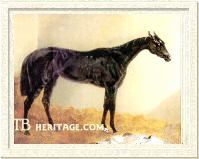
Mendicant
| |
At age two she ran second to Sting in her only outing, the Lavant Stakes for two year olds at Goodwood. At age three she won the 1,000 Guineas, beating Mowerina (dam of West Australian) and six others, and followed that by winning the Oaks easily in a drive beginning about 500 yards from the finish, over a very good field of fillies. She was not placed in the Liverpool Cup that year, and paid a compromise fee in a match at Newmarket against Conspiracy (a filly she beat in the Oaks that exclusively won matches). At age four, 1847, she beat Conspiracy by a neck in a match at Newmarket, and then ran second in the Chester Cup, and won the Cheshire Stakes at Chester. |
After this race, she was purchased by Hawley for 2,500 guineas. She ran for him in the Emperor of Russia's Plate (Ascot Gold Cup) at Ascot, in which she failed to place, and was then retired by Hawley to his stud.
Installed at Leybourne, she produced nine foals for Hawley; her first, Misericorde, an 1849 filly by Don John, died young; her next, born in 1850, was a colt, Friar Tuck, by Old England. She was barren in 1851, and in 1852, produced the filly Supplicant by Cowl or Nutwith, and then skipped a year, foaling a colt, Gaberlunzie, by Don John, in 1854. Her fifth foal was Beadsman, by Weatherbit, and through him she became grandam of two classic winners. She produced four more youngsters, the only one of significance today being her 1858 daughter by Stockwell, Vaga, who was dam of the good race filly Belphoebe (1,000 Guineas, Coronation Stakes and other good races), and of Stray Shot, dam of dual classic winner Shotover. A number of good stakes winners descended from Vaga in tail-female line, including the American stakes winning filly Frizette who later was ancestress of the French Derby winner and top sire Tourbillon; Seattle Slew was also a tail-female descendant of Vaga.
Beadsman's sire, Weatherbit, stood at Easby Abbey Stud near Richmond in Yorkshire, owned by Richard Machell Jacques, a founder of the Gimcrack Stakes and a principal in reviving racing at York when the meetings were threatened with discontinuance in the 1840s. Weatherbit was a moderately successful stallion at the time, in the mid and late '50s, with a stud fee of 15 guineas, within the same range as Derby winner Teddington (20 guineas), Surplice (15 guineas), and Cotherstone (12 guineas), but far below the top fees commanded by such blockbuster sires as Bay Middleton (50 guineas) and The Flying Dutchman (50 guineas). |
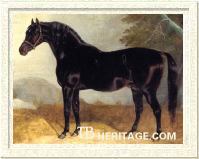
Weatherbit | |
Weatherbit was bred by Thomas Orde-Powlett of Bolton Castle, near Middleham in Yorkshire in 1842, and sold to the aforementioned John Gully, who owned him for the first year of his racing career. Weatherbit's dam was Miss Letty, by Derby winner Priam, who led the sire's list in England twice, and in America four times. She won one of her three races at age two, a 100 sovereign produce sweep at Doncaster, and at age three won the Oaks against a field of twelve other good fillies in 1837. In her other three races of that season, her last, she won two: a race for fillies at York, and a Queen's purse at Lincoln over two miles, winning both heats. Her half-sister, Miss Julia (by Partisan) produced the Grand National Steeplechase winner Little Charley. |
Weatherbit's sire was Sheet Anchor, a son of Lottery, and a strong stayer that beat another good stayer, St. Leger winner Hornsea, when the distance was three miles. Thus, Weatherbit had a strong heritage of stoutness.
Weatherbit did not start until age three, and his first race was the Derby, in which he ran unplaced. In his next race he won the Welcome Stakes at Ascot, beating a decent group of three year olds, including a July Stakes and future Drawing Room Stakes winner (Old England, also owned by Gully) and a future Great Ebor Handicap winner (Arthur). He next ran second to Miss Elis for the 2 mile-3 furlong Goodwood Cup, in a large field. He failed to place in the St. Leger, won by The Baron, and finished his season by running second in a Three Year Old Stakes over the St. Leger course at Doncaster.
In 1846 he opened the season by running second to Chamois in the 2-1/4 mile Great Metropolitan Stakes at Epsom. He then won a 3 mile-5 furlong sweepstakes at Goodwood for four year olds, beating the previous year's Derby runner-up, Annandale, the 1845 1,000 Guineas winner Pic-Nic, and two other horses. After this race he was sold to the Duke of Bedford.
In 1847 Weatherbit ran second, by a length in the 1 mile Craven Stakes at Newmarket, after which he was retired to stud with an initial fee of 5 guineas. He was a moderately successful stallion whose fee rose with the success of his offspring, and usually passed on his staying ability, although Beadsman was by far his best. He also sired Weathergage (1849), which won the Cesarewitch; Weatherbound (1857), a filly which won the Cambridgeshire; Brown Bread (1862), winner of Newcastle's 2 mile Northumberland Plate, where he beat the great racemare Caller Ou in a long-remembered dual and later an influential sire of jumpers in Ireland; The Farmer's Son, winner of the Great Eastern Handicap, and Doncaster Cup winner Mandrake (1864). A number of his daughters bred on, among them Frolicsome, dam of Grand Prix de Paris winner, Frontin (1880). Another daughter, Weatherwitch, was sent to America, where she became the second dam of Hindoo, and third dam of the great race mare Firenzi.
Mendicant dropped Beadsman in 1855 at Hawley's Leybourne stud; he was in-bred 3 x 4 to Tramp, through his dam and his sire. Beadsman, like his sire and paternal grandsire, did not "inherit that fatal gift of beauty which has so often proved a snare and a delusion to breeders." He was a dark brown leggy colt, light in bone, with a long, plain head, a lengthy, arched neck, and heavy, straight shoulders. He had a long back and drooping quarters. When grown, ultimately to 15.3 hands, his strengths were his muscular forearms and gaskins, and his clean, sound legs, but he retained his wiry appearance throughout his life. He also was said to have his dam's beautiful action.
Neither he, nor another youngster owned by Hawley, Fitz-Roland, were attractive or promising as yearlings, and they were unsuccessfully offered to anyone who would take their engagements for the classics; two years later, Fitz-Roland went on to win the 2,000 Guineas for Hawley, and Beadsman the Derby. Both youngsters were placed in the care of Hawley's new private trainer, George Manning, at Cannons Heath, near Kingsclere. In addition to these two colts, Manning also trained Hawley's Musjid to a win in the Derby of 1859.
Beadsman on the Turf
Beadsman was unsuccessful in his two races at age two: the Ham Stakes, won by the Melbourne daughter Blanche of Middlebie, in which he ran unplaced, and a handicap stakes at Goodwood, in which he ran third to Toxophilite by Longbow and a colt by Bay Middleton, with Toxophilite conceding 8 pounds to Beadsman. |
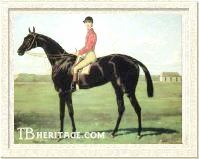
Beadsman as a racehorse | | With a year's growth on him, he came out at age three to win two sweepstakes in a row at Newmarket, followed by a dead-heat with the Orlando son, Eclipse, in the 1-1/2 mile Newmarket Stakes. In the Derby, The Druid noted, "...nothing could possibly be finer than the style in which he swept past the Stand at Epsom to the astonishment of both Lord Derby and Flatman (Toxophilite's jockey), who believed that the beating which Toxophilite gave him at Goodwood, the year before, when conceding him 8 lb., could not on this occasion, at even weights, be possibly reversed." Hawley was reputed to have won £80,000 in wagers on Beadsman in the Derby. |
Following the Derby, Beadsman easily won the second year of the Triennial Stakes at Stockbridge over 1-1/2 miles, and in October recieved a 25 sovereign compromise from Happy Land at Newmarket, his last race. He had been taken out of training and transferred to Leybourne, and so a scheduled match against American Richard Ten Broeck's great race mare Prioress, was forfeited, as was a scheduled match against Eclipse, and another scheduled for 1859 at Newmarket against a brother to Bird on the Wing, owned by Lord Glasgow. Thus ended Beadsman's short career on the turf, although he apparently retired sound. Hawley had little interest in running his horses in the Doncaster St. Leger; neither Teddington, Musjid nor Blue Gown, all Derby winners, were nominated for it.
Beadsman in the Stud
Beadsman was one of those horses whose owners rush to judgement regarding their offspring, and later repenting, rush to recover what they realize was an extremely valuable animal. He entered the stud in 1860, and Hawley bred his four best mares to him, including his first classic winner, Miami, but he attracted little consideration from other mare owners. He continued in this fashion for several years, supported largely by Hawley's own mares, with four foals in 1861, five in 1862, nine in 1863, and ten in 1864. In 1865, the year Blue Gown, Green Sleeve and Rosicrucian were born, Beadsman was shipped off to a public stable in Middlethorpe, Yorkshire (although not before being bred to Salamanca, dam of Pero Gomez) , "soliciting in vain a ten guineas fee from northern breeders." When Blue Gown, Green Sleeve and Rosicrucian successively won at age two in 1867, Beadsman was rapidly brought back from Yorkshire to recommence stud duties at Leybourne, with a much fuller book, although by then, his best offspring were already on the ground. |
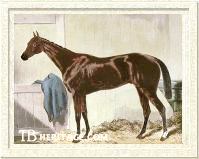
Blue Gown
| |
BLUE GOWN (1865) was a sweet-tempered, compact, short-legged, 15.3 hand bay colt out of the Stockwell daughter, Bas-Bleu, who ran unsuccessfully several times at the age of three. Bred by Hawley, Blue Gown was the fourth, and last, of his Derby winners, and in that Derby of 1868, Hawley also had two other Beadsman youngsters running: Rosicrucian, coming off a winter of illness, and the filly Green Sleeve. Their owner had backed Rosicrucian heavily for the win, and had not wagered on Blue Gown, markedly favored by the public, who had lost a secret trial to Rosicrucian by a neck just before the Derby. |
BLUE GOWN, schooled by trainer John Porter, was a decent two year old, winning the Sunning Hill Stakes, the Fernhill Stakes, and Newmarket's Clearwell Stakes, the latter in a canter; he also won Doncaster's Champagne Stakes, but was disqualified for undeclared weight, and ran third in the Weston Stakes. He ran unplaced in his only other race that season, a sweepstakes. At age three he ran second in the Biennial at Newmarket, and two other small races at Newmarket that were preps for the Derby, which he also won. He followed that by winning the Ascot Gold Cup, beating Speculum and one other horse, and then the Fitzwilliam Stakes at Doncaster. He did not place in the Cesarewitch in the fall, won by the lightly-weighted Cecil. He ran second in See-Saw's Cambridgeshire Handicap Stakes, carrying heavier weight than the winner. He also won a free handicap and two walk-overs that year. At age four, in 1869, he won the Trial Stakes at Epson, the Newmarket Biennial, the Queen's Plate at Winchester, the Craven Stakes at Goodwood, and three other races, and also took walk-overs in the Newmarket Spring Craven Stakes. He ran second to the good race filly Brigantine in the Ascot Gold Cup and to Suffolk in the Brighton Champagne Stakes.
BLUE GOWN was sold at the end of 1869 to a French syndicate for 5,000 guineas. Although he was intended to run in the big races in France, he only ran in the Grand Prix de la Ville at Lyon, where he did not place. Sold to Prince Plass, he was returned to England where he ran five times, winning one small race and running third in a Queen's Plate at Lincoln. After this he was retired and sent to stud in Austria; he became leading sire in Austria-Hungary in 1879, a year after he was shipped back to England (1878), where he stood at Cobham Stud, operated by a breeding investment syndicate. He joined three other Derby winners there, Blair Athol, George Frederick, and Macaroni. In 1879 BLUE GOWN and the stallion See-Saw were moved from Cobham to bloodstock speculator Hume Webster's new stud at Marden Deer Park, where he stood one season for a fee of fifty guineas. Webster was very good at marketing the horses bred at Marden Deer Park, particularly to foreign purchasers; in the fall of 1880 American James R. Keene (owner of Domino) purchased Blue Gown for his Kentucky Castleton Stud. Shipped from the Victoria Docks in London, Blue Gown "had an attack of the megrims and knocked himself about so much that he received injuries which caused his death during the voyage." He left less than a dozen foals in England from his stay at Cobham and Webster's stud, with most of his daughters retained there and bred young to other farm stallions, and several were bred and sold overseas. None of them left much of a mark in the stud. |
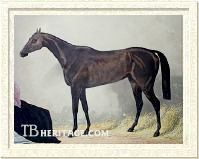
Pero Gomez
| |
PERO GOMEZ, bred by Hawley and trained by John Porter, was born in 1866. His dam, Salamanca, was by the Chatham son, Student, a brother to dual-classic winner Governess. He had the Beadsman gaskins, and was upright in front, with subsequent leg problems, and he was only kept in training for two seasons.
In his first race at age two, the Middle Park Plate, he beat a large field of good juveniles, going off at odds of 100 to 30, and winning by a length. His only other race that year was the Criterion Stakes at Newmarket, in which he dead-heated with the Wild Dayrell colt, Wild Oats.
|
At age three, he won the Biennial at Newmarket Craven, and then ran second to Pretender in the Epsom Derby, and second to Martyrdom in the Prince of Wales' Stakes. In his next outing he won the Ascot Derby, beating Monarque, and followed that by winning the St. Leger, beating both Martyrdom and Pretender, and other good horses. He followed this by winning the Doncaster Stakes, and then took two walk overs, for the Grand Duke Michael Stakes and the Royal Stakes at Newmarket. The final race of his career was a Free Handicap at Newmarket, where he placed third, conceding 30 pounds to the winner, and 26 pounds to the horse that ran second.
At stud at the Peel Bonehill stud in Staffordshire he sired some moderately successful racehorses, among them Pontiac, a handsome black colt, imported in utero to the U.S., his dam, Agenoria (by Adventurer) having been purchased by Pierre Lorillard in 1880. Because he showed great speed in a trial at Lorillard's Rancocas Stud, Pontiac was sent back to England to the trainer Tom Cannon, but failed to win there, and returned to the U.S. in 1884. Back at Rancocas, he showed considerable improvement, and went on to win eight races in 1885, beating some top horses. He was unbeatable at 6 furlongs, and outran himself to win the Suburban Handicap at 1-1/4 miles. He ran for several more years, and at stud at the Donner Ramapo Stud, sired Ramapo, who won the Metropolitan and Suburban handicaps in 1894.
Another successful Pero Gomez son on the turf was Peregrine (1873) out of a Young Melbourne mare; he won the 2,000 Guineas, beating Lorillard's great U.S. horse, Iroquois, and ran second to him in the Epsom Derby. Another Pero Gomez son, Sir Charles (1878, from Prosperity, by Ethelbert), won the New Stakes. Pero Gomez's son out of the the half-bred mare St. Faith, The Maroon, won the Irish Grand National in 1888.
Pero Gomez's daughters were a modest lot on the turf: Connie, an 1884 filly out of the King Tom mare Hilarity, ran twice as a juvenile, winning the Stand Plate at Sandown over ten furlongs, and unplaced in her only other race. Titania II, from the Stockwell mare Charade, ran for three years at the selling plate level, and won three times at ages two and three, and nine times in her nineteen starts at age four.
In the stud, however, Connie became second dam of Ascot Gold Cup winner and sire Santoi; Connie's daughter Lady Santoi became second dam of top winners in Argentina, including the brothers Cocles and Camarino (both by Copyright), and another Connie daughter, Conjure (1895, by Juggler) was a terrific producer, dam of 1,000 Guineas and Coronation Cup winner Winkipop (herself later tail-female ancestress of classic winners), of King Edward Stakes winner Pilliwinki, and Nassau Stakes winner Concertina. Another Connie daughter, Third Trick, was the dam of stakes winners and tail-female ancestress of a number of classic winners and of such sires as Hornbeam and Amerigo.
Titania II became tail-female ancestress of the good half-brothers Chateau Bouscaut (1927, winner of the Prix du Jockey Club and other top races), and Rodosto (1930, winner of the 2,000 Guineas and some top French Races). Another Pero Gomez daughter, Peroration (1876), was the dam of the good stayer Percidan (1889, twice winner of the 3100 meter Prix Jean Prat and of the Grosser Preis von Baden), and of his half-sister Peroraison, dam of the French stakes winner Perm. Other Pero Gomez daughters included Manzanilla (1878), a tail-female ancestress of such horses as the good runner and sire Theatrical (1982), and Lady Emily (1882), tail-female ancestress of good stakes winning horses in the U.S. A number of other Pero Gomez daughters bred on and can be seen in pedigrees in of winners on all continents.
|
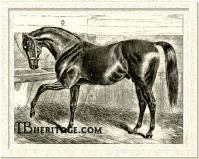
Rosicrucian, the "handsomest horse in England."
| |
ROSICRUCIAN ("Rosi") was another good colt Hawley bred from Beadsman, possibly his best. Born in 1865, his black-brown coat was similar to that of his sire's, and like other Beadsman progeny, he had powerful muscling in his forearms and gaskins. A favorite of Hawley's long-time jockey, John Wells, he was a beautiful mover at all three gaits, and Wells is said to have referred to himself and the horse as: "John Wells on Rosicrucian, the handsomest man on the handsomest horse in England." |
His groom, after his retirement to stud, thought Rosicrucian, along with Hermit and Craig Millar, horses with "the most quality I have ever seen," although unlike the even-tempered Hermit, "Rosi" could be mean, and even vicious. The Joe Andrews line died out with Rosicrucian's grandson, Doncaster Cup winner Tyrant (1885), a son of BEAUCLERC.
Rosicrucian's dam was Madame Eglantine (1857, Family 5 - i), by the Bay Middleton son Cowl, whom Hawley owned and stood at Leybourne. Out of Diversion (1838, by Defence), she was half-sister to Hawley's Oaks winner Miami, and was described as of "fine quality and symmetry." She was a fast filly who placed third in the Champagne Stakes at Doncaster, and won six juvenile races at a half-mile, but could not stay beyond that, possibly in part due to her temperament -- "Terrible stories were told of her training eccentricities; and when at the post she fretted to such an extent that she was beaten before the flag fell." Year after year, when Madame Eglantine was due to foal, she made for a particular tree in the Berkshire downs where she was pastured, and there she apparently dropped Rosicrucian, his full brother, THE PALMER, and also the Beadsman daughters MORNA (1866, a good juvenile on the turf), and the good producers MONACA (1863) and CHAPLET (1872).
Rosicrucian was born after George Manning died, and a young John Porter had assumed control of Hawley's stables at Cannons Heath; soon thereafter Porter began to make his mark as a trainer with Hawley's Beadsman youngsters, with GREEN SLEEVE (1865, Beadsman - Mrs. Quickly) and ROSICRUCIAN running one-two in Newmarket's Middle Park Plate, and GREEN SLEEVE following two days later with a win in the Prendergast Stakes. At the end of 1867 Porter and his charges moved into the new stable Hawley built at Kingsclere. The following year, as noted earlier, Porter won the Derby with Hawley's Blue Gown, and the next year both the St. Leger and Doncaster Stakes with Pero Gomez. Porter went on to train winners of 23 classic races, including Triple Crown winners Flying Fox, Ormonde, and Common. Porter later stated he considered Rosicrucian as "good as anything he ever trained," with the exception of Ormonde.
At age two ROSICRUCIAN won a maiden plate at Ascot, the Criterion Stakes, and the Troy Stakes. His second place to GREEN SLEEVE (giving her 6 lb.) in the Middle Park Plate, in which she beat him by a short head, was attributed to interference and a stumble he suffered just before the race finished. That fall, he was tried against BLUE GOWN, giving him six pounds, and beat him by six lengths; Porter rated him as ten pounds better than Blue Gown. Over the winter of 1867-8, Rosicrucian contracted the flu, and although he ran in the 2,000 Guineas, he did not place, nor did he finish well in Blue Gown's Derby. He was given time off until 1869, his four year old year, and regained his form that fall. At age five, he won six races, and showed he could win at distances between four furlongs and 2-1/2 miles. At age six, in 1871, he finished his career by winning the Ascot Stakes and the Alexandra Plate, in the latter conceding 7 lbs. to the great stayer Musket. In all, he won £6,230 while racing.
ROSICRUCIAN was sold for stud to Harry Chaplin (later Viscount Chaplin), owner of Hermit, and Lord Granville; both Chaplin and Granville were later partners in the ownership of Galopin, when he was at stud. While Rosicrucian was at Chaplin's Blakeney Stud in Lincolnshire, along with Hermit, for most of the year, during the stud season he was leased out. For three seasons he was leased to William Blenkiron, who stood him at his Middle Park Stud in Eltham; after that, in 1877, he was leased to Carew Gibson, whose stud was at Pullborough in Sussex. His groom described him as a "funny little beggar" who had some "strong dislikes," among them a "rooted objection to travelling in an ordinary railway horse-box, so we used to put him in a van, which was run on to a railway truck..."
In the stud, ROSICRUCIAN'S best offspring on the turf were two fillies: Geheimniss (1879), who was a good juvenile and at age three won the Oaks and ran second in the St. Leger (and ran well to age five, wins including the Stockbridge Cup and the All-Aged Stakes), and Hauteur, another precocious juvenile who won the Acorn Stakes, the Clearwell Stakes and Doncaster's Champagne Stakes, and at age three won the 1,000 Guineas. A son, Beauclerc, won the Middle Park Plate at age two.
ROSICRUCIAN was a good broodmare sire, his daughters including the dams of St. Leger winner Doricles (1898, out of Rosalie); Derby winner Volodyovski (1898, out of La Reine); the unbeaten juvenile and Derby winner Ladas (1891, out of Illuminata), and 2,000 Guineas winner Vedas (1902). His daughter Illuminata, in addition to producing Ladas, was the dam of Kinsky, winner of the Chester Cup, the fast filly Chelandry (winner of the 1,000 Guineas, the Woodcote Stakes and other races), and Gas (1892, by Ayrshire), dam of Derby winer Cicero and other good horses; Illuminata is a strong link in Family 1 - l, and her many tail-female descendants include Belmont Stakes winner Stage Door Johnny; the good Irish classic winners Cairn Rouge and Zarathustra; the 1980 classic-winning filly Sun Princess (Oaks and St. Leger); Derby winner and sire Shirley Heights, and many other top winners of races all over the world. Rosicrucian's daughter Agnostic was second dam of the two-time champion French sire Sardanapale.
Another Beadsman son was THE PALMER, Rosicrucian's year-older full brother, also bred by Hawley and trained by John Porter. His wins included the Ascot Derby (now King Edward VII Stakes at 2400 meters) at age three, and Liverpool's Autumn Cup (1 mile, 2 furlongs) over 16 other horses, and two other races, and he ran second to Hermit in the St. James Palace Stakes and to Julius in the Racing Stakes at Goodwood; his total wins amounted to £4,634. THE PALMER was a good sire of fillies and an important broodmare sire, and after he was sold to the state stud in Germany was twice leading sire in that country. He is the generally accepted sire of the good race filly Pilgrimage (1875), who despite bad legs, won the 1,000 and 2,000 Guineas and ran second in the Derby, breaking down in the Oaks. She was an excellent producer, dam of Derby winner Jeddah; Loved One (1883), who won three races and later became the sire of two highly influential daughters, Doris and Gondolette; and of Canterbury Pilgrim (1893), who won the Oaks, the Liverpool Summer Cup, the Jockey Club Cup and other races and in the breeding shed became dam of top broodmare sire Chaucer, of a number of daughters that bred on, and of St. Leger winner and leading sire Swynford. THE PALMER also got Oaks winner Jenny Howlet who later produced a good runner in Chitabob (1886), and her sister, Palmflower (1874), a good two year old, who became tail-female ancestress of a number of classic winners and other good stakes winners, including Derby winner Blue Peter.
Hawley also bred the Asteroid mare Girasol, to Beadsman, and in 1871 she foaled SAXON in 1871. Girasol, with Saxon at foot, was sold to Pierre Lorillard and sent to his New Jersey stud. A winner at age two, Saxon won the Belmont Stakes by a head, in a thrilling race. At stud he sired a few winners, including the bay filly Geraldine (1877), who Lorillard sent to England to run in 1878, where she won the Lavant Stakes at Goodwood. Another Beadsman youngster, BETHNAL GREEN (1869) won Newmarket's October Handicap, and a son, BEAUCLERC, won Newmarket's Middle Park Plate and later sired Doncaster Cup winner Tyrant, with whom the Joe Andrews sire line effectively ended.
|
Some of Beadsman's daughters also had their day on the turf, although none were classic winners. MORNA (1865) was one of Madame Eglentine's (Family 5 - l) stellar group of foals by Beadsman, a full sister to ROSICRUCIAN and THE PALMER. She won the Champagne Stakes as a juvenile, and at age three ran second to Scottish Queen in both the 1,000 Guineas and the Oaks, and won the Nassau Stakes at Goodwood. She did not breed on, but her sister MONACA (1863) produced a winner in Monaco (1872), who won the Steward's Cup. Another sister from Madame Eglentine, CHAPLET (1872), was an excellent producer, dam of the sire Winkfield (1885), of the good producer Snood, of Morion (1887), who won the Craven Stakes and the Ascot Gold Cup, among other races, and of Bayolia (1894), through whom she was tail-female ancestress of Oaks winner Bayuda and classic winners in Italy and France. The French stayer and sire Ex Voto also descends from Chaplet.
GREEN SLEEVE (1865), from the Longbow daughter Mrs. Quickly (Family 22 - c), as mentioned earlier, won the Middle Park Plate, beating, with some luck, ROSICRUCIAN, and a large field; she was the champion two year old filly of her year. At age three she ran in the 2,000 Guineas and the Derby, but was unplaced in both those efforts. She became the dam of Insulaire, who won the King Edward VII Stakes, the Queen Alexandra Stakes and the Prix du Jockey Club, and who was a moderately successful stallion. Other Beadsman daughters from Mrs. Quickly included BLUE SLEEVES (1869), the third dam of the Prix du Jockey Club winner Omnium II, later a good sire in France; and MERRY WIFE (1861), a tail-female ancestress of such horses as the American stakes winner Market Wise.
ARAPEILE (1864), was out of Salamanca, by Student, and so a full sister to PERO GOMEZ. She was a decent juvenile, and ran second to the top filly Achievement in the New Stakes of 1866. Another Beadsman foal from Salamanca was the 1872 colt VASCO DI GAMA, who became a sire some stakes winners in New Zealand.
POLDOODY (1870), from the great Stockwell race filly Caller Ou was a winning two year old, one of her two victories as a juvenile was Shrewsbury's Grendon Stakes; her daughter Princess Bladud (1877, by King Lud) ran for five years, her wins including the Halifax Two Year Old Stakes, and Scarsborough's Princes of Wales' Stakes and Londesborough Stakes.
Other Beadsman daughters who became good broodmares included BLUE GARTER (1863), a sister to BLUE GOWN, whose son, Blue Monkey (1878) won the German St. Leger and the Henckel-Rennen; DUVERNAY (1870, from Cachuca by Voltigeur), dam of Quicklime (1879), who won the Prince of Wales' Stakes; GOLD PEN (1863, from Steel Pen by Birdcatcher), dam of French stakes winner Silex -- Gold Pen's sister, INK, bred on successfully; JUBILANT (1873, from Jocosa by Fitz-Roland), dam of Manchester Cup winner Merry Andrew; PREFERENCE (1871, from Stockwell daughter Preface), dam of Duke of Richmond, who won the Richmond Stakes; RAGMAN ROLL (1873, from Voltigeur daughter Valtz), dam of Cesarewitch winner Ragimunde. The Beadsman daughter PULCHERRIMA, an 1873 foal out of the outstanding classic-winning filly Formosa, by Buccaneer, produced three excellent sons by Chamant in Germany: Picollos, who won the German St. Leger; Potrimpos, winner of the German Derby, and Pumpernickel, winner of the German St. Leger and Hungarian St. Leger.
Other Beadsman daughters of interest include GOURA (1863), from Columba, by Charleston, from whom descended the top U.S. runner Morvich (1919), and her sister, DOVEDALE, who was second dam of Grand Prix de Paris winner Doge. LA ROSERAIE (1873), from Crucifixion, by Pelion, became tail-female ancestress of such good French winners as Brantome (Prix d'la Arc de Triomphe), Rose Verte (French Oaks), and Mazeppa. LADY ROCKLEY (1870), from the Newminster daughter Aunt Hannah, is seen tail-female in a great number of stakes winners in Family 3, including Derby winners Pinza and Fifinella.
While the Joe Andrews branch of the Darley Arabian sire line ended, for all intents and purposes, with Beadsman's sons, with only the Rosicrucian line surviving in a modest way into the first few decades of the 20th century in Europe, his daughters, and the daughters of some of his sons, proved of sufficent value to breed on, and so he is seen in the pedigrees of some top horses up to this century.
Beadsman died from "intestinal trouble" at Leybourne Grange on July 5, 1872, age 17, the formidable Formosa being among the mares he covered in his last season that year. Hawley, disheartened by the rigidity of the Jockey Club, and in declining health, gradually ceased attending race meetings, and in 1873 disbanded his stud. He died in 1875, and in his will John Porter was offered the option of purchasing Kingsclere for £4,000, a fraction of its value, which he exercised, and from which he went on to train so many more classic winners for other clients.
-- by Patricia Erigero |
|
|
|

